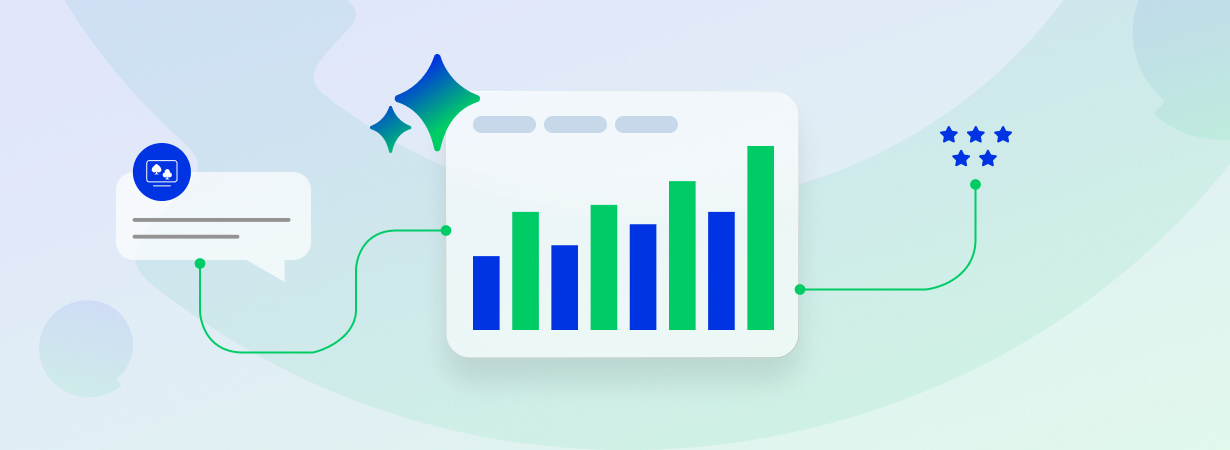Out of all the customer engagement software tools that are out there, which one is right for your company? The question is a loaded one. Different companies have different needs, and a very diverse number of customer engagement tools are waiting to fill those needs.
This blog post will cover several of the top, most sought-out customer engagement tools on the market. Some of these tools have millions of loyal users; others are newcomers or vertical market players. Regardless of what you’re looking for, we hope this post will help you decide which customer engagement solutions will be the best fit for your company.
Here’s a quick glance at what’s included in this post:
Which Factors Should I Consider When Deciding on a Customer Engagement Tool
Before you decide which customer engagement tool is right for your company, let’s take a look at the different considerations that you may need to factor into this decision:
- Industry — More and more customer engagement tools are available to cater to the needs of different industries. While many businesses will fare fine with broader customer engagement tools, searching for specific vertical market solutions is a great option for companies with industry-specific needs that are not being met by traditional software solutions.
- Business size — Do you run a small business or a large enterprise? This may influence which customer engagement tool will be able to best serve your company.
- Price — It’s important to consider your budget when looking into customer engagement tools. Depending on what you’re looking to buy and how big your business is, customer engagement software varies from free to hundreds or even thousands of dollars per month. And it’s not just the cost per agent or interaction that companies need to take into account — deployment costs can also vary per software.
- Operating system — Some customer engagement tools run better on certain platforms than on others. Before purchasing your customer engagement software solution, make sure that it is compatible with your company’s main operating system (Windows, Mac OS, Linux, etc). Another thing to watch out for is whether a customer engagement tool integrates with your existing core systems, such as your CRM system (if you have one). If it doesn’t, the purchase may not be worth going forward with unless you’re looking to change your core systems as well.
- Method of Deployment — Back in the day, customer engagement software was always implemented on site. Nowadays, companies have a choice of whether to purchase software with on-premises deployment or a web-based software solution that stores data on the cloud.
- Need — It’s easy to get distracted with everything that customer engagement software vendors will sell you. Before you buy, reflect on what it is that your company actually needs. Consider your company’s goals, and focus in on the software that will help your company achieve these goals.
Popular Customer Engagement Software Tools and Who They’re Good For
The following use cases were written to show which kinds of businesses will most benefit from different customer engagement solutions. We’ve included some pros and cons of each software, along with price, industry, deployment method, and other useful information to help your company get to know these solutions. All data is the most recent information available as of the beginning of 2018.
Powerful live chat software
Offer real-time, personalized, efficient support that your customers and agents will love at 1/3 the cost of voice support.
Learn more
Comm100 Live Chat
1. Business Seeks Industry-Leading CRM
Salesforce
Salesforce is often considered the gold standard for CRM solutions. That’s because it is one of the most acclaimed and reputable CRM software solutions around, with customers such as Coca Cola and American Express vouching for its effectiveness.
Salesforce features a robust reporting system, advanced customization options, and a powerful database that keeps track of contacts across channels. Online reviews of engagement tools show that Salesforce has the best user-friendly interface when compared to other CRM software solutions such as Siebel and SugarCRM. Salesforce has been successful as a mobile customer service application, meeting the increasing demands of businesses and customers. Due to its popularity, most other customer engagement tools have Salesforce integrations, meaning that Salesforce can easily be paired with tools such as live chat, social media, and marketing software.
While Salesforce is the best of the best, one of its downsides is its steep price. Although Salesforce boasts being fit for any business size, the cost and time that it takes to customize it for a small companies and startups can be considerable. Making changes to this software is complicated, and Salesforce works best for businesses who can afford to hire an on-site Salesforce administrator. For small businesses, the price of making even small changes can pile up quickly.
Salesforce has faced complaints about contract negotiations and low pricing flexibility. With the price as a deterrent for some smaller organizations, Salesforce is best used by large and enterprise companies.
- Great for: Enterprises looking to spend on an industry-leading CRM software solution; medium and large businesses with big budgets.
- Not Great for: Startups and small businesses looking to save, or who just need something simple.
- Specs:
- Industry: Any (although Salesforce also has a Health Cloud which reimagines this powerful CRM specifically for health professionals).
- Business size: Any (although it is most accessible and powerful when used by medium/large/enterprise businesses)
- Price:
- Sales Cloud ranges from $25-$300/user/month
- Service Cloud ranges from $75-$300/user/month
- Sales + Service Cloud ranges from $100-$325/user/month
- Salesforce Platform (for building aps) ranges from $25 to more than $4000/user/month
- Health Cloud ranges from $300-$450/user/month
- Marketing and Commerce Clouds require users to call for estimates.
- OS: Windows, Mac OS, web browser
- Deployment: Cloud-based
- Need: An industry-leading CRM — features include lead scoring, SMS marketing, event management, sales reports, social CRM, mobile app, web content personalization, and more.
Competitors: Lithium, Oracle, Pipedrive, Microsoft Dynamics 365
2. Business on a Budget Seeks Uncomplicated CRM
Less Annoying CRM
Less Annoying CRM has received praise from businesses on a budget — namely small business owners — for its ease of use, uncomplicated functions, and great value for the price. This program works great for managing a few hundred leads, and makes CRM simple. However, while it’s good at the basics, this software lacks more advanced functions. If you are looking for advanced lead sorting, email template customization or mobile features, then this software is not for you. This software also does not perform advanced automation — it can, however, integrate with automation giant, MailChimp.
- Great for: Small businesses looking for a product that is affordable and that has a great value for the cost.
- Not Great for: Large companies or businesses looking for advanced automation options or robust customization options.
- Specs:
- Industry: Any
- Business size: Small
- Price: $10/user/month
- OS: Windows, Mac OS, web browser
- Deployment: Cloud, SaaS, Web
- Need: CRM — includes lead tracking, note taking, calendars, task management; sales force automation (SFA)
Competitors: Capsule CRM, Insightly, Really Simple Systems
3. Business Seeks Industry-Specific CRM
There are many reasons your business might want an industry-specific or vertical market CRM. Perhaps a generic CRM tool doesn’t fit the needs of your brand, or perhaps you want more advanced features specifically suited for your company without having to pay for extra add-ons.
Astute Solutions
Astute Solutions is a CRM built to meet the distinct and changing demands of various industries. This CRM solution offers customer service and social media integrations, knowledge management for digital self-service, conversational bots and more. Astute has specific CRM solutions for the industries such as the restaurant industry (McDonalds, Domino’s, and Buffalo Wild Wings use this CRM), the airline industry (serving British Airways and Aer Lingus), the CPG – or consumer packed goods — industry (McCormick and Co., Bush Brothers and Company, and Land O’Lakes use this CRM), and more.
Here are some other Industry-Specific CRMs by industry:
- Accounting
- BTC Software: Based in the UK, this software is good for small to medium sized tax and accountancy practices and corporates
- Automotive Dealerships
- Auto Jockey: Provides tools for capturing customer activity and information, social media, and sales and service integration
- DataCar CRM: Allows for appointment scheduling, activity reports, multi-channel marketing, and more
- Education
- Azorus: A CRM tool for the higher education market that helps universities and higher education institutions recruit the right students
- Education Link: A system for student management, invoicing, course management, and sales
- Freelancers
- Dubsado: A client management system designed to help creative entrepreneurs with everything from invoicing to brand promotion
- Plutio: Designed for freelancers and small teams, this CRM brings projects, tasks, invoices, and files into one centralized platform
- Insurance
- Cloudia: Designed to improve efficiency and profitability of insurance agencies, saving time and boosting sales
- AgencyBloc: An agency management system that helps life and health insurance agencies grow their business with commissions processing, integrated business and marketing automation, and more
- Restaurants
- Hot Schedules: Good for managing labor and cost control
- DataCar CRM: Allows for appointment scheduling, activity reports, multi-channel marketing, and more
- Travel and Tourism
- Dolphin CRM: Travel technology that encompasses CRM, reservations, and booking engines for businesses, travel agents and tour operators
- Emerald ISO Travel Solutions: A CRM that meets the needs of the tourism market, providing campaign management systems, complaint management, brochure fulfillment and more
If your business is in a different industry that wasn’t covered, you can check out which vertical market CRM is right for your business here.
- Great for: Vertical market or industry-specific CRMs are great for companies who aren’t getting all that they need from a standard CRM, or who are having to use many tools to perform industry-specific functions.
- Not Great for: Companies who want a more powerful CRM that easily plugs into other customer engagement software instead of an industry-specific CRM.
- Specs:
- Industry: Any
- Business size: Any
- Price: Varies per software; the pricing for Astute Solutions is available upon request
- OS: Check for each individual software
- Deployment: Check for each individual software
- Need: CRM plus industry-specific software tools
4. Company with Reliable CRM Seeks Hassle-Live Chat Software
Comm100
For companies that have found a reliable CRM to track customer activity, the next step is to take on a software solution that actually helps encourage and increase customer engagement. One of the ways to do this is with a quality live chat provider.
Comm100 is a customer engagement solution with live chat as its hub — or core function. Its mission is simple — help companies of all sizes provide quality customer experiences, regardless of channel.
Comm100’s live chat tool is designed to help businesses of all sizes and industries improve customer satisfaction rates, and engage with their customers in real time. Studies show that consumers prefer and are more satisfied with live chat over other communication methods, and Comm100 makes it easy for businesses to deliver on these preferences.
Comm100 offers different types of solutions for different kinds of businesses. Functionality for the mid-price point edition includes:
- Easy implementation
- A user-friendly interface
- Flexible pricing
- Unlimited chats
- Chat window and button customization
- Chat routing to multiple departments
- Real time visitor monitoring
- 24/7 live chat support
- Mobile apps to help businesses chat with customers on the go
Comm100’s Enterprise-ready edition offers all this, plus advanced chat allocation, powerful queue management tools, automatic visitor recognition, key performance indicator (KPI) reporting, agent performance evaluation, 24/7 chat volume reports and more.
Although Comm100 is primarily a customer service software, it also acts as a sales solution, helping contact centers convert leads and upsell products in real time, just as a salesperson might do in a brick-and-mortar store. This software solution also helps maximize agent productivity and optimize scheduling, making sure that no company resources go to waste.
- Great for: Companies who already have a phone system and CRM — especially Salesforce — and who want a bolt-on piece of software that adds extra channels with little hassle, gives advanced routing and reporting capabilities, etc.
- Not Great for: Companies who want a solution which contains a fully-fledged CRM; businesses who aren’t interested in advanced functionality and just want something basic.
- Specs:
- Industry: Any
- Business size: Any
- Price:
Team — $29/agent/month
Business — $49/agent/month
Enterprise — Call to request demo
- OS: Windows, Mac OS, Linux, Android, iPhone/iPad, Windows Mobile
- Deployment: Private or shared cloud-based deployment or on-premises deployment
- Need: Customer service software, sales tools, omnichannel software, live chat software
Competitors: BoldChat, LiveChatInc
5. Business Seeks All-in-One Customer Service Software
Zendesk
Zendesk was founded in 2007 by three friends using an old kitchen door as a desk. A leader in help desk services, Zendesk now has over 2,000 employees and serves 114,000 customers in 150 countries and territories.
Zendesk offers a range of products to help companies improve their customer relationships. These products include call center software, live chat integration, customer support management tools, knowledge base tools, and a shared team inbox. Zendesk’s ticketing system works to collect all customer support requests and manage them in a single location, making it easier for agents to help customers reach satisfaction.
Zendesk integrates well with other customer engagement tools, such as CRMs, bug trackers, and third party live chat software.
Many enterprises opt for Zendesk as a customer service software. However, for startups and smaller organizations, Zendesk can be a little complex, over-featured, and pricey. Zendesk divides its software into separately priced sub-products, meaning that to get its full omnichannel functionality, you have to pay more. As one reviewer put it: “Zendesk’s biggest advantage is its highly developed, comprehensive environment – useful to big customer service teams operating on many levels. Used partially, Zendesk loses its ‘wow’ effect.”
- Great for: Companies who already have a phone system and CRM — especially Salesforce — and who want a bolt-on piece of software that adds extra channels with little hassle, gives advanced routing and reporting capabilities, etc.
- Not Great for: Startups, small businesses, businesses on a budget.
- Specs:
- Industry: Any
- Business size: Any
- Price:
Essential — $5/agent/month
Team — $19/agent/month
Professional — $49/agent/month
Enterprise — $99/agent/month
Elite — $199/agent/month
Zendesk chat has a monthly add-on price ranging from $0 (Lite) to $70 (Enterprise). Knowledge base software and call center software also come at additional fees.
- OS: Windows, Mac OS, Linux, web browser, Android, iPhone/iPad
- Deployment: Cloud, SaaS, Web
- Need: Call center software, customer support tools, live chat software, knowledge base software, omnichannel support
Competitors: Moxie, Re:amaze
6. Company Seeks Social Media Software with a Focus in Marketing
Hootsuite
Hootsuite is one of the largest and most comprehensive social media managers out there, and it’s not without reason. Their mission is to help businesses manage all their social media accounts in on place, so that they can do more with their social media.
As a social media software, Hootsuite offers support for the following:
- Twitter profiles
- Facebook profiles, pages and groups
- Google+ pages and profiles
- LinkedIn profiles and companies
- WordPress blogs
- Instagram profiles
It also features apps to extend its functionality to other social media platforms, such as Pinterest and YouTube (a majority of these integrations are free). With Hootsuite, companies can schedule social media updates and even automate posts according to the time that customers are most likely to engage. Different accounts can have different permissions — ranging from default to admin to super admin — ensuring that teams can collaborate easily according to these rolls.
Hootsuite also lets businesses build influencer lists, engage in social listening, and set contests and campaigns. As a social media software, it excels in marketing.
Like live chat software, Hootsuite’s social media software provides analytics and reports to help companies best understand how their social media strategies are performing. These advanced reports can be sorted into custom “boards”, and cover a range of different social data points.
Similar to other popular customer engagement software solutions, Hootsuite’s downsides affect mainly small businesses and businesses on a budget. While Hootsuite has some free reports, the system requires that customers buy reports using points. This means that companies who are serious about monitoring their social media performance may have to pay extra in order to do so.
Another downside to Hootsuite is that companies can only track engagement on click-through links that have been added from Hootsuite. Clicks on third-party URL shorteners do not end up in Hootsuite’s reporting, and Hootsuite itself only supports a limited number of URL shorteners for adding links to posts. Another criticism of Hootsuite is that the bulk scheduler posts statuses on Facebook that do not include a thumbnail or image summary, making links less clickable.
- Great for: Medium, large, and enterprise businesses with a large marketing budget. Medium businesses should have limited social media team members, to avoid paying high costs for additional members.
- Not Great for: Small businesses, businesses on a budget, social media management for multiple clients.
- Specs:
- Industry: Any
- Business size: Any
- Price:
Free (1 user, 3 social profiles, only 30 scheduled posts)
Professional (1 user, 10 social profiles, unlimited posts) — $19/month
Team (3 users, 20 social profiles, unlimited posts) — $99/month
Enterprise — Call for consultation
- OS: Windows, Mac OS, Linux, web browser, Android, iPhone/iPad
- Deployment: Cloud, SaaS, Web
- Need: Social media marketing and management
Competitors: Sprout Social, Buffer, Edgar, Salesforce Social Studio
7. Business Seeks Social Media Software with Integrated Social CRM
Sprout Social
One of Hootsuite’s main competitors, Sprout Social is a social media software tool that boasts an easy, inviting user experience.
Sprout Social presents all connected profiles in a single, unified stream (although businesses have the option to filter their feed by social profile). Additionally, Sprout Social’s smart inbox allows users to mark different messages as “complete,” so that social inquiries are less likely to be missed and fall through the cracks.
One of Sprout Social’s biggest strengths is its built-in Social CRM system. As Zach Watson from Technology Advice explains: “For every account that follows you or that you follow, Sprout Social creates a record that stores interaction history as well as basic contact information. This information can be immensely helpful for salespeople, another way to build marketing and sales alignment.”
Sprout Social works with the following social media integrations:
- Twitter accounts
- Facebook pages
- Google+ pages
- LinkedIn pages
- Instagram accounts
One of Sprout Social’s main disadvantages is that it integrates with less social networks than Hootsuite. Another downfall to this software is that it only has two scheduling options — one for weekdays, and one for weekends. That means that customers who want to schedule posts for different times day by day are out of luck. Sprout Social also only allows a maximum of 10 posts per day, which can be very limiting to companies who want to post more frequently as part of their social media strategy.
What it lacks in integrations, Sprout Social makes up for in comprehensive, readable reporting. Unlike Hootsuite, Sprout Social does not charge additional fees for reports (that being said, Sprout Social’s reporting is also not quite as robust as Hootsuite’s).
Another drawback to Sprout Social is that it requires customers to pay a higher monthly fee per user to unlock social listening capabilities. In general, the cost of Sprout Social can be prohibitive to include all members of a large team, or for businesses on a budget.
- Great for: Medium to enterprise businesses with a large social media budget; businesses who are looking for a Social CRM
- Not Great for: Businesses whose social needs include YouTube, Pinterest, Snapchat, or other social platforms not covered by Sprout Social. Customers who are primarily interested in social listening would also be better matched with a different software
- Specs:
- Industry: Any
- Business size: Any
- Price:
Premium (includes 10 social profiles) — $99/user/month
Corporate (includes 15 social profiles) — $149/user/month
Enterprise (includes 20 social profiles) — $249/user/month
5 Additional Profiles $25/month
- OS: Windows, Mac OS, Linux, web browser, Android, iPhone/iPad
- Deployment: Cloud-based, SaaS, Web
- Need: Social media marketing, Social CRM
Competitors: Hootsuite, Buffer, Jollor, SocialPilot
8. Business Seeks Powerful Email Marketing Automation Tool
MailChimp
Live chat and social media marketing may be on the rise, but email marketing is still alive and well, especially through MailChimp.
MailChimp is the world’s largest marketing automation platform, and a well-known email newsletter service. Their goal is to help businesses and shops of all sizes find their audience, engage their customers, and build their brand.
MailChimp stands out from its competitors in their commitment to providing quality, low-cost marketing software to small and growing businesses. As MailChimp says on their website, their mission is to “help small businesses grow by democratizing powerful marketing tools that are often reserved for large enterprises.” It’s a mission that has earned them millions of loyal customers and fans across industries.
Today MailChimp serves over 14 million customers. For businesses with under 2000 email subscribers, MailChimp offers its services at no cost. As of mid 2017, those services also include free marketing automation. That includes automated welcome emails, shopping cart abandonment reminders, and more. Businesses can also create professional campaigns using email templates, personalize campaigns based on customer interests, and check campaign progress with free reports.
With MailChimp, companies can create a landing page with a call to action, prompting website visitors to become subscribers. Several other features are available through MailChimp (such remarketing ads fulfilled by Google and social media marketing campaigns), at an additional cost.
As a downside, MailChimp does not support contact tagging or have advanced lead segmentation options. For advanced users, MailChimp’s customization capabilities are quite limited, and the software can be seen as inflexible. MailChimp also doesn’t support SMS marketing, or have the CRM capabilities that more seasoned marketers desire.
- Great for: Small businesses, startups, and businesses with 2000 or fewer subscribers
- Not Great for: Large businesses and enterprises; businesses looking to spend more to get a more advanced marketing automation tool
- Specs:
- Industry: Any
- Business size: Any, however it is ideal for small to medium businesses
- Price:
Forever Free (2000 or fewer subscribers) — Free
Growing Business — Starting at $10/month
Pro Marketer — Growing Business price plus an additional $199/month
Pay as you go options also available
- OS: Windows, Mac OS, Linux, web browser, Android, iPhone/iPad
- Deployment: Cloud-based
- Need: Email marketing automation; professional email campaigns
Competitors: ActiveCampaign, ConvertKit (for professional bloggers)
9. Company Seeks an All-in-One Marketing Software that Doubles as a CRM
HubSpot
HubSpot is one of the most popular marketing automation software companies in the world. This inbound marketing software platform helps companies attract visitors, convert leads, and increase customer loyalty. HubSpot includes tools for social media marketing, social listening, content management, web analytics, landing pages, and search engine optimization (SEO), among others.
HubSpot opens marketing up well beyond email, creating a multichannel marketing experience for its users. By nurturing leads across various platforms, HubSpot promises superior lead conversion, a full-funnel inbound strategy, and an amplified ROI on both inbound and traditional marketing.
What makes HubSpot attractive is its “all-in-oneness”. HubSpot integrates three main functions that businesses often have to seek out distinct tools for: CRM, Marketing, and Sales. The purpose of this, the company says, is so that your business can stop worrying about scattered tools and focus on growing revenue.
Despite HubSpot’s all-in-oneness, it is rich with third-party integrations. From Salesforce to Survey Monkey, HubSpot makes it easy for companies to connect to their favorite software solutions.
Despite several positives in their favor, HubSpot has some notable cons. According to Marketing Automation Insider, HubSpot is notorious for price creep and lock-in contracts:
“While HubSpot [does] have a $200/month package, marketing automation and [third party] CRM integration are only offered at their $800/month package, which includes only 1,000 contacts. As your requirements and contacts grow, so does this cost (quite rapidly).”
HubSpot’s 12-month contract is also less convenient than the month-by-month contract that other software solutions offer. For a solution that is catered to small and medium businesses, HubSpot is on the pricey side.
- Great for: Small to medium businesses with a large marketing budget; businesses that want an all-in-one marketing solution
- Not Great for: Businesses on a budget; enterprises that need a more robust system to fit their needs; businesses that do not want or need an all-in-one solution tool
- Specs:
- Industry: Any
- Business size: Any (small to enterprise)
- Price:
Free
Starter — $50/month
Basic — $200/month
Professional — $800/month
Enterprise — $2400/month
Onboarding ranges from $600-$20,000 (one-time payment)
- OS: Windows, Mac OS, Linux, web browser, Android, iPhone/iPad
- Deployment: Cloud, SaaS, Web
- Need: CRM; Sales; Marketing (Social media, email, web, and more)
Competitors: Ontraport (specializes in small businesses and entrepreneurs), Infusionsoft (specializes in small businesses), Marketo (specializes in enterprises)
10. Company Seeks Tool for Advanced Marketers
Marketo
Marketo is a cloud-based marketing solution that was built to fit the marketing needs of companies of any size. This engagement software allows companies to create, manage, and execute personalized engagement with customers across every touchpoint: email, web, mobile, and more.
Where HubSpot focuses on inbound marketing, Marketo has traditionally been associated with B2B marketing because of their deeper focus on lead nurturing.
Since Marketo specializes in custom solutions for enterprises, their software tends to require more IT knowledge to operate. Like with employing Salesforce, Marketo is best used if you have a marketing technologist with software experience on site. With the right amount of software knowledge, your business will be able to truly appreciate the array of features Marketo offers.
Although Marketo doesn’t come equipped with their own CRM, it was designed using Salesforce as the CRM. As a result, Marketo integrates seamlessly with Salesforce — a huge plus for businesses who use this CRM. In all, Marketo’s has over 365 applications and integrations with third-party platforms.
Once set up, businesses report that Marketo is easy to use. Unfortunately, if your business does not have an expert to help with the setup process, starting off with this software can be challenging. For small teams, the learning curve can be especially tough, and may mean that many small teams won’t get the best use out of this software. Marketo has also been criticized for their poor landing page builder and steep price jumps.
- Great for: Teams with advanced software knowledge or an expert on-site
- Not Great for: Small teams; teams just getting started with marketing software; teams on a budget
- Specs:
- Industry: Any
- Business size: Any
- Price:
Basic — $895/month
Pro — $1,795/month
Elite — $3,195/month
- OS: Windows, Mac OS, Linux, web browser, Android, iPhone/iPad
- Deployment: Cloud, SaaS, Web
- Need: Advanced marketing technology
Competitors: HubSpot, Oracle Eloqua, Salesforce Pardot
11. Business Seeks PR Software to Monitor Brand Across All Media
Cision
Cision is the largest PR database in the world and the “granddaddy of all PR databases.”. This full-featured software covers every aspect of corporate communication needs, helping businesses reach, target, and engage with their audience.
Cision provides insights into things like social media engagement, brand health, crisis mitigation, consumer sentiments, social impact, investor relations, government relations, and more. Its strong analysis, media list building, and distribution capabilities make it a frontrunner in the PR software industry.
To help companies make quality PR connections, Cision has a database of over 1.6 million journalists, influencers, and editorial contacts. Cision’s amplification campaigns help businesses show off their content in recommended content modules across the internet.
Cision’s negative point? You guessed it — this software is extremely pricy and not for everyone. In 2014 Cision charged $5,700 per year for a single license to access its media database. Pricing information is now only available by demand, but it’s likely that the price has increased since then.
- Great for: Businesses with a large PR budget; advertising agencies, news organizations, government offices, and other organizations with high spending power and an audience to reach
- Not Great for: Businesses with a medium to low PR budget
- Specs:
- Industry: Any
- Business size: Large to Enterprise
- Price: Contact Cision for details
- OS: Windows, Mac OS, Linux, web browser, Android, iPhone/iPad
- Deployment: Cloud-based
- Need: Connect with influencers, journalists, etc.; Monitor public sentiment; Advanced PR tool
Competitors: Muck Rack, GroupHigh
12. Company Seeks Omnichannel Customer Support Software
Shopify Plus
Shopify Plus is Shopify’s solution to omnichannel customer engagement. This multichannel ecommerce platform allows businesses to optimize sales channels across mobile, social, and in-store.
Built specifically for retail, Shopify Plus includes one-click integrations to help companies sell products natively across social networks. This includes enabling instant purchases through Facebook, Pinterest, Instagram, and other visually stimulating social feeds.
Shopify Plus’s omnichannel capabilities extend to mobile too. This software solution allows companies to create mobile friendly storefronts and enable mobile payments through hundreds of gateways, such as PayPal, Apple Pay, Shopify Pay, and more. It’s other shopping capabilities — such as in person and wholesale — make this a quality omnichannel solution for retail.
The downsides to Shopify Plus are these: Shopify Plus is only available for Enterprises, and is more for marketing than it is a great content management system. Additionally, Shopify has a platform lock-in, which makes it hard to switch ecommerce platforms. As one reviewer notes, “if Shopify runs into financial trouble, you bear that vendor risk. If you want to close your store and migrate to a new platform, you can only get the data that Shopify exports for you.”
- Great for: Ecommerce businesses
- Not Great for: Small businesses that won’t benefit from an enterprise solution; Other industries that won’t benefit from having an online shop; companies that want a more powerful sales solution
- Specs:
- Industry: Retail, food and beverage, fashion, home furnishing, beauty and cosmetics
- Business size: Enterprise
- Price: Contact Shopify for details (Start around $2000 per month)
- OS: Windows, Mac OS, Linux, web browser, Android, iPhone/iPad
- Deployment: Cloud-based
- Need: Sales
Competitors: BigCommerce Enterprise, Magento Enterprise
OmniPath by Lucep
Lucep is an AI startup company that developed a “click to call” customer engagement solution that helps businesses increase their online lead generation and conversion capabilities.
Lucep combines web and mobile technologies to generate a live chat-like pop-up window that prompts website visitors to click to receive a call from an agent. Should a visitor choose to accept this invitation, they need only to enter a name and a phone number where they can be reached — within minutes an agent will reach out to them.
Like live chat, Lucep’s software ensures that customers don’t have to go through the hassle of fighting with an automated machine or waiting in a long queue to speak with a representative. Instead, they are connected quickly and securely with a call center agent who can assist them with their needs.
Lucep’s OmniPath software is an omnichannel customer engagement platform for enterprises — streamlining customer journeys and integrating customer relationship management. Whether a customer reaches out to your business via mobile apps, the company website, social media, SMS, in-branch or even over the phone, Lucep will share the user journey data across all channels. That way, when a customer does click to call, an agent can reach out to them with the right information.
The downside to Lucep is that while Lucep is a live chat alternative, it does not solve support needs of every customer. While some customers may appreciate the option to receive a call from a representative, others prefer the more laid back, multitask-friendly nature of live chat, which Lucep cannot provide (live chat, on the other hand, with its audio and video integrations, can provide the same sort of service as Lucep). Lucep also has limited integration capabilities, which is a deterrent to some buyers. Lucep is geared more heavily towards sales than customer service.
- Great for: Businesses seeking a live chat alternative
- Not Great for: Businesses looking to move away from telephony and embrace digital service
- Specs:
- Industry: Any
- Business size: Omnichannel tool is only available to enterprises
- Price: Contact Lucep for details
- OS: Windows, Mac OS, Linux, web browser, Android, iPhone/iPad
- Deployment: Cloud-based
- Need: Sales, Customer service
Comm100
Comm100 has come far in growing its omnichannel capabilities. What started out as a live chat provider is now a customer engagement software solution that offers social media integrations, knowledge base software, AI/Chatbot services, and even more channels on the roadmap.
Comm100’s social media integration helps businesses to serve their customers on Facebook, Twitter, and Facebook messenger just like they would on live chat. Social media inquiries and comments pop up on the same dashboard as live chat, and can be sorted, filtered, prioritized and assigned to different individuals or departments.
Another channel that Comm100 provides is audio and video chat. While most customers prefer text chatting, there are times when an issue can be resolved more quickly via audio or video. With audio and video chat, international customers and potential customers can call in without incurring high international dialing fees. Audio and video chat offers new possibilities across industries — for example, in the healthcare industry, doctors can use video chat to check in on and even diagnose a patient from the comfort of their home. With audio and video chat, confidential information can be passed securely from customer to agent.
Comm100’s knowledge base can easily integrate with live chat, providing a better customer and agent experience through self-service. One or more knowledge bases can be set up and integrated within the chat window for website visitors to access before chats begin, and agents can also look up knowledge base information with a single click. Like the knowledge base, Comm100’s AI or Chatbot integration can handle basic, predetermined customer queries, allowing agents to be freed up to handle more complex questions and issues.
Through integrations, Comm100 fully supports customers improving efficiency, innovation, and achieving a truly omnichannel solution through third party CRMs, analytics, and more.
- Great for: Companies who already have a phone system and CRM — especially Salesforce — and who want a bolt-on piece of software that adds extra channels with little hassle, gives advanced routing and reporting capabilities, etc.
- Not Great for: Companies who are only looking for CRMs or marketing solutions; businesses who aren’t interested in advanced functionality and just want something basic
- Specs:
- Industry: Any
- Business size: Any
- Price:
Team — $29/agent/month
Business — $49/agent/month
Enterprise — Call to request demo
- OS: Windows, Mac OS, Linux, Android, iPhone/iPad, Windows Mobile
- Deployment: Private or shared cloud-based deployment or on-premises deployment
- Need: Customer service software, sales tools, omnichannel software, live chat software
Conclusion
The right customer engagement software will put your business on the path towards higher sales, growth, and profitability. In the end, whether you choose to adopt one (or more) of these customer engagement solutions or their competitors will depend on where your company is at, where it wants to go, and what resources are available to take it there.
Download now: Everything You Need to Know About Customer Engagement Software
This eBook will help you to learn about typical software solutions, categorize them according to your needs, understand typical benefits and pitfalls, and it also comes with a handy checklist to guide your final decision.
Download Now
eBook








